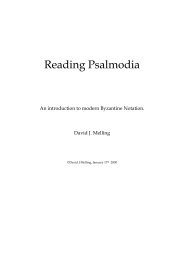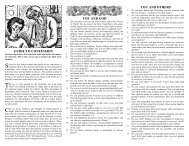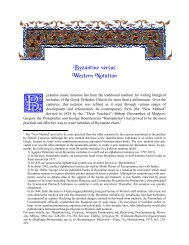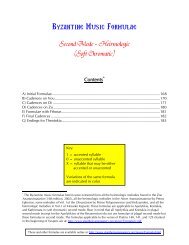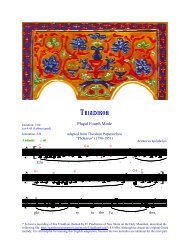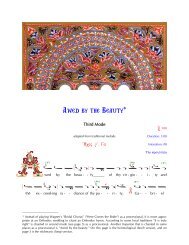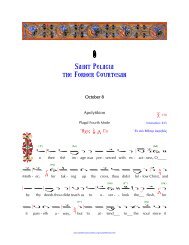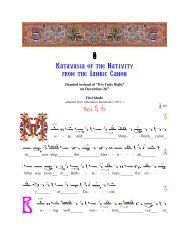- Page 3 and 4: VespersAs
- Page 6 and 7: ivContentsAposticha Theotokion ....
- Page 8 and 9: viContentsApolytikion (Dismissal Hy
- Page 10 and 11: viiiContents" " " by Hieromonk Hier
- Page 12 and 13: xConcerning AdaptationThe first ada
- Page 14 and 15: xiiConcerning AdaptationThis adapta
- Page 16 and 17: xivConcerning AdaptationThis adapta
- Page 18 and 19: xviConcerning AdaptationThis adapta
- Page 20 and 21: xviiiConcerning AdaptationComparing
- Page 24 and 25: xxiiConcerning AdaptationThe versio
- Page 26 and 27: xxivConcerning AdaptationThe follow
- Page 28 and 29: About the TranslationOUR previous b
- Page 30 and 31: xxviiiConcerning NotationTwo proble
- Page 32: AcknowledgementsTHIS book w
- Page 36 and 37: 2First Mode - Lord I Have Cried
- Page 38 and 39: 4First Mode - Verses of Psalms
- Page 40 and 41: 6First Mode - Verses of Psalms
- Page 42 and 43: Slow SticheraFirst Mode Verse #1!E
- Page 44 and 45: 10First Mode - Slow SticheraOVerse
- Page 46 and 47: 12First Mode - Slow SticheraIVerse
- Page 48 and 49: 14First Mode - Slow SticheraVerse #
- Page 50 and 51: 16First Mode - Slow SticheraVerse #
- Page 52 and 53: 18First Mode - GloryAlternate Melod
- Page 54 and 55: Dogmatic TheotokionFirst Mode 84Th
- Page 56 and 57: Slow ApostichaFirst Mode Aposticha
- Page 58 and 59: 24First Mode - Slow ApostichaVerse
- Page 60 and 61: 26First Mode - Slow ApostichaAposti
- Page 62 and 63: 28First Mode - Aposticha Theotokion
- Page 64 and 65: 30First Mode - Apolytikion
- Page 66 and 67: First Mode - BriefLord, I Have Crie
- Page 68 and 69: Brief SticheraFirst Mode Verse #1!
- Page 70 and 71: 36First Mode - Brief SticheraO ƒut
- Page 73 and 74:
First Mode - Brief Stichera39F ƒor
- Page 75 and 76:
First Mode - Brief Stichera41FVerse
- Page 78 and 79:
Brief ApostichaFirst Mode Apostich
- Page 80 and 81:
46First Mode - Brief ApostichaFVers
- Page 82:
48First Mode - Brief ApostichaGGlor
- Page 85 and 86:
Second Mode - Lord I Have Cried51
- Page 87 and 88:
Second Mode - Verses of Psalms53
- Page 89 and 90:
Second Mode - Verses of Psalms5514
- Page 91 and 92:
Slow SticheraSecond Mode Verse #1
- Page 93 and 94:
Second Mode - Slow Stichera59
- Page 95 and 96:
Second Mode - Slow Stichera61
- Page 97 and 98:
Second Mode - Slow Stichera63Stiche
- Page 99 and 100:
Second Mode - Slow Stichera65
- Page 101 and 102:
Glory… Both Now…Second Mode 8
- Page 103 and 104:
Second Mode - Glory69 Old (Slow) St
- Page 105 and 106:
Second Mode - Dogmatic Theotokion 7
- Page 107 and 108:
Second Mode - Slow Aposticha73Verse
- Page 109 and 110:
Second Mode - Slow Aposticha75
- Page 111 and 112:
Aposticha TheotokionSecond Mode 84
- Page 113 and 114:
Apolytikion of theResurrectionSecon
- Page 115 and 116:
Second Mode - Apolytikion81
- Page 117 and 118:
Second Mode - Lord I Have Cried 83
- Page 119 and 120:
Second Mode - Verses of Psalms85
- Page 121 and 122:
Second Mode - Verses of Psalms87
- Page 123 and 124:
Brief SticheraSecond Mode Verse #1
- Page 125 and 126:
Second Mode - Brief Stichera91O ƒu
- Page 127 and 128:
Second Mode - Brief Stichera93I fVe
- Page 129 and 130:
Second Mode - Brief Stichera95F ƒr
- Page 131 and 132:
Second Mode - Brief Stichera97GGlor
- Page 133 and 134:
Brief ApostichaSecond Mode Apostic
- Page 135 and 136:
Second Mode - Brief Aposticha101FVe
- Page 137 and 138:
Second Mode - Brief Aposticha103GGl
- Page 139 and 140:
Third ModeLord, I Have Cried 84Kuvr
- Page 141 and 142:
Verses of Psalms140, 141, and 129Th
- Page 143 and 144:
Third Mode - Verses of Psalms1099
- Page 145 and 146:
Third Mode - Verses of Psalms11119
- Page 147 and 148:
Third Mode - Slow Stichera113
- Page 149 and 150:
Third Mode - Slow Stichera115
- Page 151 and 152:
Third Mode - Slow Stichera117F orVe
- Page 153 and 154:
Third Mode - Slow Stichera119
- Page 155 and 156:
Glory… Both Now…Third Mode 84 D
- Page 157 and 158:
Third Mode - Glory123Old (Slow) Sti
- Page 159 and 160:
Third Mode - Dogmatic Theotokion125
- Page 161 and 162:
Third Mode - Slow Aposticha127T heV
- Page 163 and 164:
Third Mode - Slow Aposticha129
- Page 165 and 166:
Aposticha TheotokionThird Mode!Aspo
- Page 167 and 168:
Apolytikion of theResurrectionThird
- Page 169 and 170:
Third Mode - Apolytikion135
- Page 171 and 172:
Third Mode - Lord I Have Cried 137
- Page 173 and 174:
Third Mode - Brief Stichera139T heV
- Page 175 and 176:
Third Mode - Brief Stichera141LVers
- Page 177 and 178:
Third Mode - Brief Stichera143F ƒo
- Page 179 and 180:
Third Mode - Brief Stichera145FVers
- Page 181 and 182:
Third Mode - Brief Stichera147
- Page 183 and 184:
Third Mode - Brief Aposticha149Vers
- Page 185 and 186:
Third Mode - Brief Aposticha151HVer
- Page 187 and 188:
Third Mode - Brief Aposticha153
- Page 189 and 190:
Fourth Mode - Lord I Have Cried155
- Page 191 and 192:
Fourth Mode - Verses of Psalms157
- Page 193 and 194:
Fourth Mode - Verses of Psalms159
- Page 195 and 196:
Slow SticheraFourth Mode B ringVer
- Page 197 and 198:
Fourth Mode - Slow Stichera163
- Page 199 and 200:
Fourth Mode - Slow Stichera165Stich
- Page 201 and 202:
Fourth Mode - Slow Stichera167
- Page 203 and 204:
Fourth Mode - Slow Stichera169
- Page 205 and 206:
Glory… Both Now…Fourth Mode 84
- Page 207 and 208:
Fourth Mode - Glory173Old (Slow) St
- Page 209 and 210:
Fourth Mode - Dogmatic Theotokion17
- Page 211 and 212:
Slow ApostichaFourth Mode Apostich
- Page 213 and 214:
Fourth Mode - Slow Aposticha179
- Page 215 and 216:
Fourth Mode - Slow Aposticha181HVer
- Page 217 and 218:
Aposticha TheotokionFourth Mode 8
- Page 219 and 220:
Apolytikion of theResurrectionFourt
- Page 221 and 222:
Fourth Mode - Apolytikion187
- Page 223 and 224:
Fourth Mode - Lord I Have Cried 189
- Page 225 and 226:
Fourth Mode - Brief Stichera191Vers
- Page 227 and 228:
Fourth Mode - Brief Stichera193L ƒ
- Page 229 and 230:
Fourth Mode - Brief Stichera195F ƒ
- Page 231 and 232:
Fourth Mode - Brief Stichera197FVer
- Page 233 and 234:
Fourth Mode - Brief Stichera199
- Page 235 and 236:
Fourth Mode - Brief Aposticha201
- Page 237 and 238:
Fourth Mode - Brief Aposticha203HVe
- Page 239 and 240:
Fourth Mode - Brief Aposticha205
- Page 241 and 242:
Plagal First Mode - Lord I Have Cri
- Page 243 and 244:
Plagal First Mode - Verses of Psalm
- Page 245 and 246:
Plagal First Mode - Verses of Psalm
- Page 247 and 248:
Slow SticheraPlagal First ModeB rin
- Page 249 and 250:
Plagal First Mode - Slow Stichera21
- Page 251 and 252:
Plagal First Mode - Slow Stichera21
- Page 253 and 254:
Plagal First Mode - Slow Stichera21
- Page 255 and 256:
Plagal First Mode - Slow Stichera22
- Page 257 and 258:
Glory… Both Now…Plagal First Mo
- Page 259 and 260:
Plagal First Mode - Glory225Old (Sl
- Page 261 and 262:
Plagal First Mode - Dogmatic Theoto
- Page 263 and 264:
Plagal First Mode - Slow Aposticha2
- Page 265 and 266:
Plagal First Mode - Slow Aposticha2
- Page 267 and 268:
Plagal First Mode - Slow Aposticha2
- Page 269 and 270:
Plagal First Mode - Aposticha Theot
- Page 271 and 272:
Plagal First Mode - Apolytikion 237
- Page 273 and 274:
Plagal First Mode - BriefLord, I Ha
- Page 275 and 276:
Verses of Psalms140, 141, and 129Pl
- Page 277 and 278:
Plagal First Mode - Verses of Psalm
- Page 279 and 280:
Plagal First Mode - Verses of Psalm
- Page 281 and 282:
Plagal First Mode - Brief Stichera2
- Page 283 and 284:
Plagal First Mode - Brief Stichera2
- Page 285 and 286:
Plagal First Mode - Brief Stichera2
- Page 287 and 288:
Plagal First Mode - Brief Stichera2
- Page 289 and 290:
Plagal First Mode - Brief Stichera2
- Page 291 and 292:
Plagal First Mode - Brief Aposticha
- Page 293 and 294:
Plagal First Mode - Brief Aposticha
- Page 295 and 296:
Plagal First Mode - Brief Aposticha
- Page 297 and 298:
Plagal Second Mode - Lord I Have Cr
- Page 299 and 300:
Plagal Second Mode - Verses of Psal
- Page 301 and 302:
Plagal Second Mode - Verses of Psal
- Page 303 and 304:
Slow SticheraPlagal Second ModeB ƒ
- Page 305 and 306:
Plagal Second Mode - Slow Stichera2
- Page 307 and 308:
Plagal Second Mode - Slow Stichera2
- Page 309 and 310:
Plagal Second Mode - Slow Stichera2
- Page 311 and 312:
Plagal Second Mode - Slow Stichera2
- Page 313 and 314:
Plagal Second Mode - Glory279Altern
- Page 315 and 316:
Dogmatic TheotokionPlagal Second Mo
- Page 317 and 318:
Slow ApostichaPlagal Second ModeApo
- Page 319 and 320:
Plagal Second Mode - Slow Aposticha
- Page 321 and 322:
Plagal Second Mode - Slow Aposticha
- Page 323 and 324:
Plagal Second Mode - Aposticha Theo
- Page 325 and 326:
Plagal Second Mode - Apolytikion291
- Page 327 and 328:
Plagal Second Mode - BriefLord, I H
- Page 329 and 330:
Verses of Psalms140, 141, and 129Pl
- Page 331 and 332:
Plagal Second Mode - Verses of Psal
- Page 333 and 334:
Plagal Second Mode - Verses of Psal
- Page 335 and 336:
Plagal Second Mode - Brief Stichera
- Page 337 and 338:
Plagal Second Mode - Brief Stichera
- Page 339 and 340:
Plagal Second Mode - Brief Stichera
- Page 341 and 342:
Plagal Second Mode - Brief Stichera
- Page 343 and 344:
Plagal Second Mode - Brief Stichera
- Page 345 and 346:
Plagal Second Mode - Brief Apostich
- Page 347 and 348:
Plagal Second Mode - Brief Apostich
- Page 349 and 350:
Plagal Second Mode - Brief Apostich
- Page 351 and 352:
Grave Mode - Lord I Have Cried317
- Page 353 and 354:
Grave Mode - Verses of Psalms319
- Page 355 and 356:
Grave Mode - Verses of Psalms32114
- Page 357 and 358:
Slow SticheraGrave Mode Verse #1!E
- Page 359 and 360:
Grave Mode - Slow Stichera325
- Page 361 and 362:
Grave Mode - Slow Stichera327
- Page 363 and 364:
Grave Mode - Slow Stichera329F ƒor
- Page 365 and 366:
Grave Mode - Slow Stichera331
- Page 367 and 368:
Glory… Both Now…Grave Mode 84D
- Page 369 and 370:
Grave Mode - Glory335Old (Slow) Sti
- Page 371 and 372:
Grave Mode - Dogmatic Theotokion 33
- Page 373 and 374:
Diatonic Grave Mode - Dogmatic Theo
- Page 375 and 376:
Slow ApostichaGrave Mode Aposticha
- Page 377 and 378:
Grave Mode - Slow Aposticha343F ƒo
- Page 379 and 380:
Aposticha TheotokionGrave Mode 84
- Page 381 and 382:
Apolytikion of theResurrectionGrave
- Page 383 and 384:
Grave Mode - Apolytikion349
- Page 385 and 386:
Grave Mode - Lord I Have Cried351
- Page 387 and 388:
Grave Mode - Brief Stichera353Verse
- Page 389 and 390:
Grave Mode - Brief Stichera355L etV
- Page 391 and 392:
Grave Mode - Brief Stichera357F orV
- Page 393 and 394:
Grave Mode - Brief Stichera359FVers
- Page 395 and 396:
Grave Mode - Brief Stichera361
- Page 397 and 398:
Grave Mode - Brief Aposticha363Vers
- Page 399 and 400:
Grave Mode - Brief Aposticha365HVer
- Page 401 and 402:
plagal fourth modeLord, I Have Crie
- Page 403 and 404:
Verses of Psalms140, 141, and 129Pl
- Page 405 and 406:
Plagal Fourth Mode - Verses of Psal
- Page 407 and 408:
Plagal Fourth Mode - Verses of Psal
- Page 409 and 410:
Plagal Fourth Mode - Slow Stichera3
- Page 411 and 412:
Plagal Fourth Mode - Slow Stichera3
- Page 413 and 414:
Plagal Fourth Mode - Slow Stichera3
- Page 415 and 416:
Plagal Fourth Mode - Slow Stichera3
- Page 417 and 418:
Plagal Fourth Mode - Glory383Altern
- Page 419 and 420:
Dogmatic TheotokionPlagal Fourth Mo
- Page 421 and 422:
Slow ApostichaPlagal Fourth ModeApo
- Page 423 and 424:
Plagal Fourth Mode - Slow Aposticha
- Page 425 and 426:
Plagal Fourth Mode - Slow Aposticha
- Page 427 and 428:
Aposticha TheotokionPlagal Fourth M
- Page 429 and 430:
Apolytikion of theResurrectionPlaga
- Page 431 and 432:
Plagal Fourth Mode - Apolytikion397
- Page 433 and 434:
Plagal Fourth Mode - Lord I Have Cr
- Page 435 and 436:
Plagal Fourth Mode - Brief Stichera
- Page 437 and 438:
Plagal Fourth Mode - Brief Stichera
- Page 439 and 440:
Plagal Fourth Mode - Brief Stichera
- Page 441 and 442:
Plagal Fourth Mode - Brief Stichera
- Page 443 and 444:
Plagal Fourth Mode - Brief Stichera
- Page 445 and 446:
Plagal Fourth Mode - Brief Apostich
- Page 447 and 448:
Plagal Fourth Mode - Brief Apostich
- Page 449:
Plagal Fourth Mode - Brief Apostich
- Page 452 and 453:
418I Shall Go into Thy House
- Page 454 and 455:
420Anoixantaria - Phokaeus
- Page 456 and 457:
422Anoixantaria - PhokaeusLVerse #4
- Page 458 and 459:
424Anoixantaria - Phokaeus
- Page 460:
426Anoixantaria - PhokaeusOVerse #8
- Page 463 and 464:
Anoixantaria - Phokaeus429
- Page 465 and 466:
Anoixantaria - Phokaeus431
- Page 467 and 468:
Anoixantaria - Raidestenos433
- Page 469 and 470:
Anoixantaria - Raidestenos435LVerse
- Page 471 and 472:
Anoixantaria - Raidestenos437
- Page 473 and 474:
Anoixantaria - Raidestenos439
- Page 475 and 476:
Anoixantaria - Raidestenos441
- Page 477 and 478:
Anoixantaria - Raidestenos443
- Page 479 and 480:
Anoixantaria - Raidestenos445
- Page 481 and 482:
Anoixantaria - St. John Koukouzeles
- Page 483 and 484:
Anoixantaria - St. John Koukouzeles
- Page 485 and 486:
Anoixantaria - St. John Koukouzeles
- Page 487 and 488:
Elaborate Finale*for Anoixantaria *
- Page 489 and 490:
Anoixantaria - Elaborate Finale455
- Page 491 and 492:
Anoixantaria - Elaborate Finale457
- Page 493 and 494:
Blessed is the Man - Long Version45
- Page 495 and 496:
Blessed is the Man - Long Version46
- Page 497 and 498:
Blessed is the Man - Long Version46
- Page 499 and 500:
Blessed is the Man - Long Version46
- Page 501 and 502:
Blessed is the Man - Long Version46
- Page 503 and 504:
Blessed is the Man - Long Version46
- Page 505 and 506:
Blessed is the Man(psalms 1-3)Brief
- Page 507 and 508:
Blessed is the Man - Brief Version4
- Page 509 and 510:
Blessed is the Man - Brief Version4
- Page 511 and 512:
Blessed is the Man - Brief Version4
- Page 513 and 514:
Blessed is the Man - Brief Version4
- Page 515 and 516:
Lord I Have Cried - Very Long Versi
- Page 517 and 518:
Lord I Have Cried - Very Long Versi
- Page 519 and 520:
Lord, I Have CriedVery Long Version
- Page 521 and 522:
Lord I Have Cried - Very Long Versi
- Page 523 and 524:
Verses of Psalms140, 141, and 129Tr
- Page 525 and 526:
Verses of Psalms - Triple Meter - F
- Page 527 and 528:
Verses of Psalms - Triple Meter - F
- Page 529 and 530:
Verses of Psalms140, 141, and 129Tr
- Page 531 and 532:
Verses of Psalms - Triple Meter - P
- Page 533 and 534:
Verses of Psalms - Triple Meter - P
- Page 535 and 536:
O Joyous LightSecond Modeadapted fr
- Page 537 and 538:
O Joyous LightSecond Modeadapted fr
- Page 539 and 540:
Daily ProkeimenaT ƒheSaturday <str
- Page 541 and 542:
Daily Prokeimena507T heMonday <stro
- Page 543 and 544:
Daily Prokeimena509Wednesday <stron
- Page 545 and 546:
Daily Prokeimena511Friday V
- Page 547 and 548:
Lenten Prokeimena513 h
- Page 549 and 550:
Lenten Prokeimena515"Thou H
- Page 551 and 552:
Great ProkeimenaFor Feas</s
- Page 553 and 554:
Great Prokeimena519For Bright Monda
- Page 555 and 556:
Great Prokeimena521For Bright Wedne
- Page 557 and 558:
Great Prokeimena523For Bright Frida
- Page 559 and 560:
Rich Men Have Turned Poor - Brief V
- Page 561 and 562:
Rich Men Have Turned Poor - Long Me
- Page 563 and 564:
Rich Men Have Turned Poor - Long Me
- Page 565 and 566:
Rich Men Have Turned Poor - Long Me
- Page 567 and 568:
O Theotokos and Virgin - Georgiadis
- Page 569 and 570:
O Theotokos and Virgin - Georgiadis
- Page 571 and 572:
O Theotokos and VirginPlagal First
- Page 573 and 574:
O Theotokos and VirginPlagal First
- Page 575 and 576:
Lord Have MercyPlagal Fourth Modead
- Page 577 and 578:
Lord Have Mercy - Plagal Fourth Mod
- Page 579 and 580:
Lord Have Mercy - Plagal Fourth Mod
- Page 581 and 582:
Lord Have Mercy - Plagal Fourth Mod
- Page 583 and 584:
Lord Have Mercy - Plagal Fourth Mod
- Page 585 and 586:
Lord Have Mercy - Plagal First Mode
- Page 587 and 588:
Lord Have Mercy - Plagal First Mode
- Page 589 and 590:
Lord Have Mercy - Plagal First Mode
- Page 591 and 592:
Lord Have Mercy - Plagal First Mode
- Page 593 and 594:
LLord Have Mercyadapted from Athoni
- Page 595 and 596:
Grant This O Lordadapted from Hiero
- Page 597 and 598:
Grant This O Lord - Plagal Fourth M
- Page 599 and 600:
Grant This O Lordadapted from Micha
- Page 601 and 602:
Grant This O Lord - Plagal First Mo
- Page 603 and 604:
SourcesThe music for all the hymns
- Page 605 and 606:
AppendixThe Intonations of the Eigh
- Page 607 and 608:
The Intonations of the Eight Modes
- Page 609 and 610:
The Intonations of the Eight Modes
- Page 611 and 612:
The Intonations of the Eight Modes
- Page 613:
Glory be to Godfor all things



